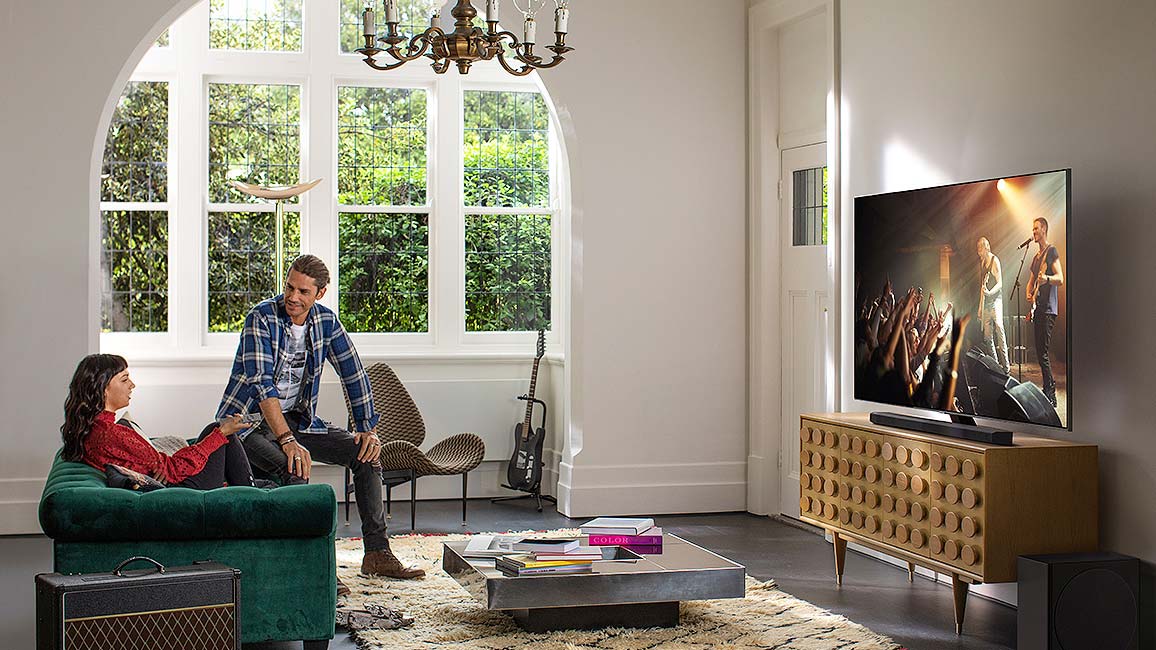This Samsung QLED TV stole my heart from OLED — here’s why

As long as I’ve been testing TVs, I’ve lusted after OLED. I even wrote about how the Sony A8H Bravia ruined all over TVs for me, romanticizing my experience with it in a way that was alarmingly telling of my social behaviors (or lack thereof) during quarantine. The question of whether you should buy QLED vs OLED TVs had a clear answer, if you asked me.
But that’s changed. I’ve been using the Samsung Q80T QLED TV, and I think it’s made me a believer in LCD again. Look, I still think OLED TVs are the best TVs you can buy. However, after spending some time with the Q80T, I could make the case for purchasing a QLED instead of our overall favorite TV right now, the LG CX OLED. Samsung’s set has LG’s beat in tested brightness and costs several hundred dollars less.
Despite similarities in name, QLED and OLED are not the same thing. In fact, they’re two competing technologies for TV displays. QLED is basically an elevated, Samsung-branded version of LCD that’s since been adopted by manufacturers like TCL, Vizio and more. It adds a quantum filter, enhancing contrast and color beyond what we came to expect from LCD for many years.
In OLED — or organic light-emitting diode — panels, individual pixels produce light. This lets select areas of the screen turn completely off, creating so-called true blacks. Many smartphones, monitors and even the Apple Watch, employ OLED displays, but its distinct characteristics are far more evident on a 65-inch TV screen.
According to Tom’s Guide TV testing, our proprietary system of TV benchmarks, OLED and QLED sets have different strengths. QLED dominates in terms of brightness, while OLED is king of color. We measure color reproduction using a X-Rite i1 Pro spectrophotometer and SpectraCal CalMAN Ultimate calibration software, and our top-performing OLED covers over 134% of the Rec 709 color space.
While the Samsung Q80T QLED reproduces 99.9% of our tested color spectrum, it’s given me anecdotal freedom I didn’t have with the Sony A8H Bravia OLED TV: Strong performance in a room with natural lighting. Whenever I test OLED TVs, I disappear to a dark basement like a movie villain descending to their lair. The lack of light is ideal for formal testing, but a bit limited for my everyday viewing.
I set up the Samsung Q80T QLED above ground level, and for the first time in a few years I’m enjoying watching TV during the day, blinds open and all. It has done wonders for my mood, and it’s not just because of Friday mornings with WandaVision. Now that I can enjoy my favorite shows while also getting Vitamin D, I’m sold on QLED. It’s a revelation to use a TV that holds up against sun glare.
Get instant access to breaking news, the hottest reviews, great deals and helpful tips.
The blacks might not look as truly black as OLED’s do, specifically in the daytime. But in one of my favorite scenes for testing contrast capabilities the QLED held its own. As Kylo Ren explored Exegol in the opening of Star Wars: Rise of Skywalker, stumbling upon an alive Emperor Palpatine a strobe effect flashed the screen between dark and intense bright quickly. The Q80T maintained contrast, providing a sophistication as good as any LED/LCD set can offer.
So are Samsung's QLED TVs worth it? Absolutely, if you’re shopping for a new TV to put in a well-lit room. OLED is still the way to go if you’re a basement dweller, or perhaps do most of your movie watching after the sun goes down. I also still have an affinity for the Sony Bravia A8H OLED, but I also have been known to sport rose-colored glasses when recalling technology I’ve reviewed in the past. Although I’ll always remember that OLED as an exemplary piece of hardware, QLED has rightfully earned part of my TV-loving heart, too.

Kate Kozuch is the managing editor of social and video at Tom’s Guide. She writes about smartwatches, TVs, audio devices, and some cooking appliances, too. Kate appears on Fox News to talk tech trends and runs the Tom's Guide TikTok account, which you should be following if you don't already. When she’s not filming tech videos, you can find her taking up a new sport, mastering the NYT Crossword or channeling her inner celebrity chef.
